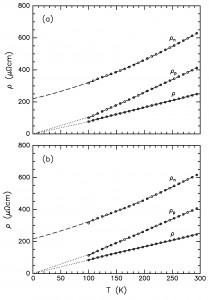Coexisting Holes and Electrons in High-TC Materials: implications from normal state transport, D. R. Harshman J. D. Dow and A. T. Fiory [arXiv]
Normal state resistivity and Hall effect are shown to be successfully modeled by a two-band model of holes and electrons that is applied self-consistently to (i) DC transport data reported for eight bulk-crystal and six oriented-film specimens of YBa2Cu3O7–δ, and (ii) far-infrared Hall angle data reported for YBa2Cu3O7–δ and Bi2Sr2CaCu2O8+δ. The electron band exhibits extremely strong scattering; the extrapolated DC residual resistivity of the electronic component is shown to be consistent with the previously observed excess thermal conductivity and excess electrodynamic conductivity at low temperature. Two-band hole-electron analysis of Hall angle data suggest that the electrons possess the greater effective mass.
D. R. Harshman, J. D. Dow and A. T. Fiory, Philos. Mag. 91, 818 (2011).












